BY JANET STEINBERG
Much is often said about seeing the wondrous sights made by Mother Nature. But don’t neglect to see the wondrous sights made by man. The ingenuity of man has also created some pretty astonishing sights, many of which are destinations unto themselves. The myriads of incredible, man-made sights around the world are much more than mere structures. They can be artworks that evoke emotion or buildings that exude history, breathe nostalgia, tell a story, or give sheer joy just by looking at them. Come along with me as we travel the world in search of some of man’s many memorable accomplishments.
PRAGUE, CZECH REPUBLIC: “Fred and Ginger” (The “Dancing House”), named after the famous dancers Fred Astaire and Ginger Rogers, exudes nostalgia. When gazing at this “dancing house”, those of a certain age cannot help but recall the graceful couple who dominated the musicals on the silver screen many decades ago. This ultra-contemporary, once-controversial, building, whose twirling twin towers appear to be dancing, was awarded the Best Design of 1996 prize by Time Magazine. Architect Frank Gehry designed the swaybacked structure that is next to two Art Nouveau houses built by the grandfather of former Czech President Václav Havel. Czech it out!
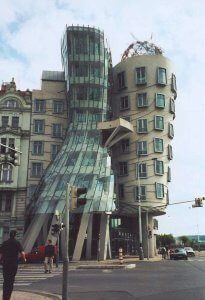
FRED AND GINGER… THE DANCING HOUSE
SYDNEY, AUSTRALIA: The soaring sails of the $102 million Sydney Opera House (often dubbed “The Other Taj Mahal”) breathtakingly dominate the harbor of this vibrant sprawling metropolis of more than 3 million people. Like the Taj, the Opera House–a spectacular architectural concept rising from the sea at Bennelong Point–is the realization of human aspirations and ambitions. This national symbol, that took about 19 years to build, has what might be the most famous roofs in the world. Made from 2,194 concrete sections that weigh up to 15 tons, they are held together by 217 miles of tensioned cable and are covered with more than 1,056,000 Swedish-made, white and cream-colored ceramic tiles. The total roof weight is 157,800 tons and the highest shell roof is 221 feet above sea level. The profile of its famous concrete roofs depicts different things to different people: “A huddle of nuns in the wind”; “an echo of the sails of yachts on the harbor”; or “some gigantic, magnificent but utterly strange hard-shelled sea creature which has come up from the bottom of the water to rest on Bennelong Point”.
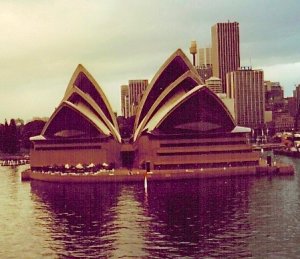
SYDNEY OPERA HOUSE IS OFTEN CALLED THE OTHER TAJ MAHAL
ST. PETERSBURG, RUSSIA: On the outskirts of the city, some 20 miles west of St. Petersburg, is one of the most exquisite, former summer residences of the Imperial Court. Peterhof, formerly known as Petrodvorets, was inspired by Versailles and contains what might well be the most exquisite water display in the world. The Grand Cascade, with its 64 water jets and 37 gold statues provides a spectacular setting for the renowned Sampson Fountain. The lavish Great Palace has been skillfully restored to repair the WWII damage. A tip for the wise: take along a box lunch to eat in the exquisite garden. It’s a picnic you’ll never forget.
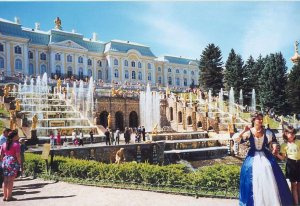
PETERHOF THE FORMER SUMMER RESIDENCE OF THE IMPERIAL COURT
BILBAO, SPAIN: With his undulating Guggenheim Museum, Frank Gehry transformed the former industrial town that was once dubbed the ugliest city in Europe, into a vibrant metropolis that exceeded the townsfolk’s wildest imagination. From a distance, the splendid bizarrely shaped $100-million museum, which opened in 1997, looks like a massive steel sculpture. The museum’s Pritzker prize-winning architect describes his building, on the banks of the Nervion River, as a ship that has run aground. Others have likened the silhouette of Bilbao’s Guggenheim to a roller coaster, a mermaid, a waterfall, a hula girl, and a fish. Philip Johnson, the dean of American Architects, called the building “ the most important building of our time”.
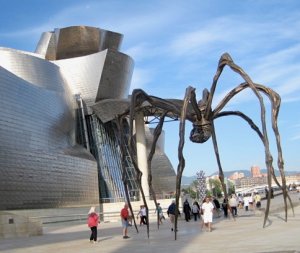
BILBAO’S GUGGENHEIM MUSEUM (AND LOUISE BOURGEOIS’ SPIDER “MAMAN”)
BUDAPEST, HUNGARY: Taking the waters” at the Gellert Spa, in the “Spa Capital of Europe”, is a Pesti (pronounced peshtee) t
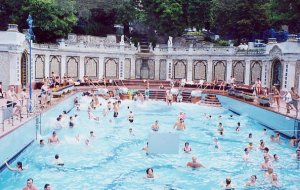
ART NOUVEAU GELLERT SPA
MANAUS, BRAZIL: Grandest of all the relics of the past splendor of Manaus is the fabled Teatro do Amazona, the ornate, salmon-colored Opera House with its mesmerizing mosaic plaza, French crystal mirrors, and Italian marble and rare wood floors. The Great Enrico Caruso, Anna Pavlova, and Sarah Bernhardt were all said to have performed in that grand restored Opera House that opened in 1896 at a cost of $10 million. When you visit this magnificent Domenico de Angelis-designed structure, with its lovely trompe l’oeil dome, you will be instructed to cover your shoes with duck-like slippers before you can walk upon the elegant wood ballroom floor.
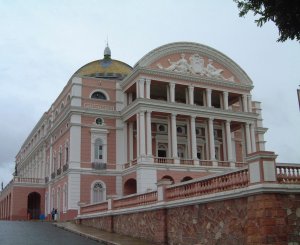
TEATRO DO AMAZONA… THE MANAUS OPERA HOUSE
JANET STEINBERG, winner of 55 national travel-writing awards, resides in Cincinnati but calls the world her home.
PHOTO CREDITS: Janet Steinberg
